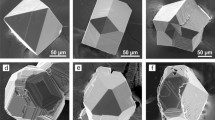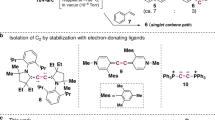Abstract
THE conventional catalyst-solvents used in the high-pressure, high-temperature synthesis of diamonds from graphite are the group VIII metals, Cr, Mn, Ta, and their alloys1,2. A number of other substances have been claimed to act as catalyst-solvents for the graphite-to-diamond reaction, but at the extremely high pressures and high temperatures involved, contamination by the known group VIII catalysts used in the construction of the high-pressure cells may have promoted the diamond-forming reaction. It has been demonstrated experimentally that at sufficiently high static pressures and temperatures graphite will transform spontaneously to diamond3–6 but the pressures and temperatures are about twice those required for the reactions aided by the conventional catalyst-solvents. Thus substances which may be sub-marginal as catalyst-solvents at the usual diamond synthesis pressures and temperatures might become fairly effective at higher pressures and temperatures7,8.
This is a preview of subscription content, access via your institution
Access options
Subscribe to this journal
Receive 51 print issues and online access
$199.00 per year
only $3.90 per issue
Buy this article
- Purchase on Springer Link
- Instant access to full article PDF
Prices may be subject to local taxes which are calculated during checkout
Similar content being viewed by others
References
Bovenkerk, H. P., Bundy, F. P., Hall, H. T., Strong, H. M., and Wentorf, jun., R. H., Nature, 184, 1094 (1959).
Bundy, F. P., Bovenkerk, H. P., Strong, H. M., and Wentorf, jun., R. H., J. Chem. Phys., 35, 383 (1961).
DeCarli, P. S., and Jamieson, J. C., Science, 133, 1821 (1961).
Bundy, F. P., J. Chem. Phys., 38, 631 (1963).
Wentorf, jun., R. H., J. Phys. Chem., 69, 3063 (1965).
Bundy, F. P., and Kasper, J. S., J. Chem. Phys., 46, 3437 (1967).
Strong, H. M., J. Chem. Phys., 39, 2057 (1963).
Shterenberg, L. E., Slesarev, V. N., Vereshchagin, L. F., and Zhukov, A. A., Sov. Phys.-Doklady, 16, 327 (1971) (translated from Doklady Akad. Nauk SSSR, 197, 1302 (1971)).
Russian Patent in Ireland, 560/71, May 5, 1971.
Russian Patent in Ireland, 626/71, May 8, 1971.
US Patent, No. 3,676,068 (July 1972).
“Characterization of the High Pressure Environment”, Nat. Bur. Stds. Spec. Publ., No. 326 (edit. by Lloyd, E. C.), 53 (Washington, DC, 1971).
Author information
Authors and Affiliations
Rights and permissions
About this article
Cite this article
BUNDY, F. Diamond Synthesis with Non-conventional Catalyst-solvents. Nature 241, 116–118 (1973). https://doi.org/10.1038/241116a0
Received:
Issue Date:
DOI: https://doi.org/10.1038/241116a0
This article is cited by
-
Behaviour of graphite-diamond conversion using Ni-Cu and Ni-Zn alloys as catalyst-solvent
Journal of Materials Science (1990)
Comments
By submitting a comment you agree to abide by our Terms and Community Guidelines. If you find something abusive or that does not comply with our terms or guidelines please flag it as inappropriate.



